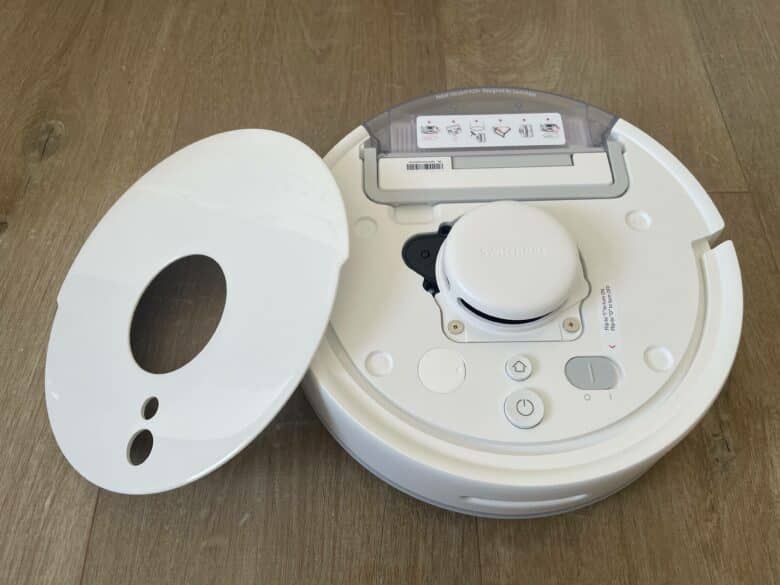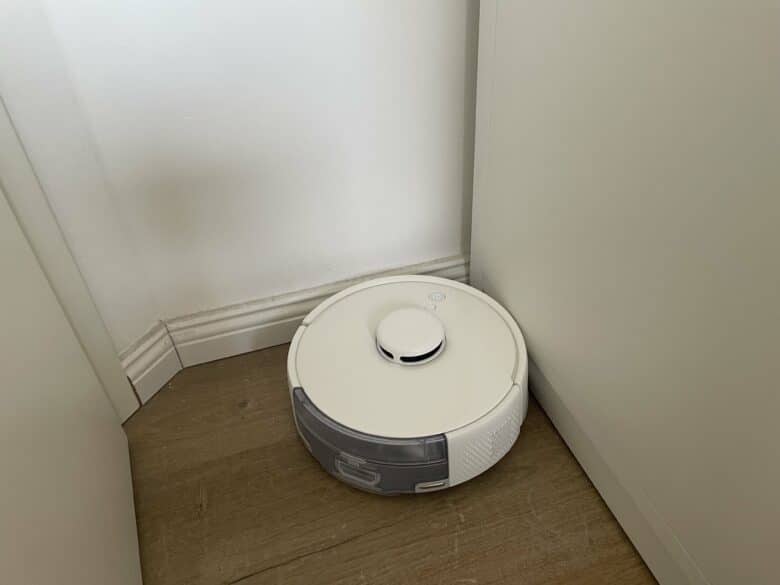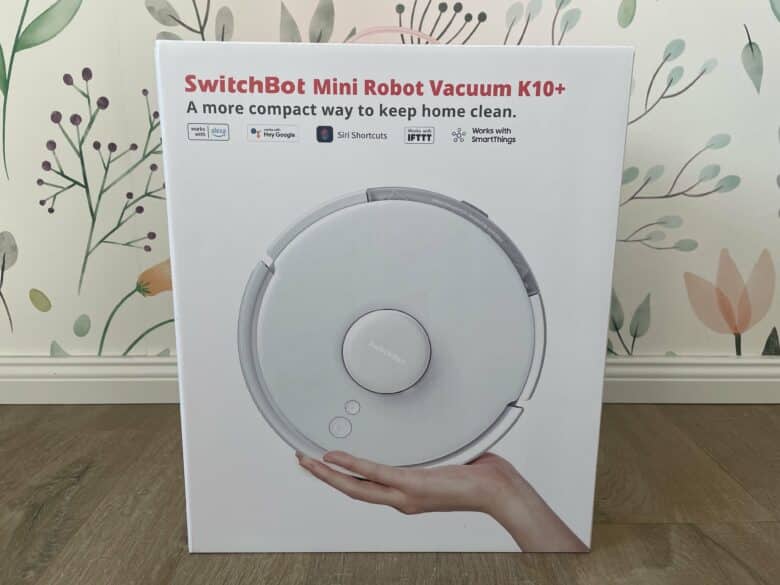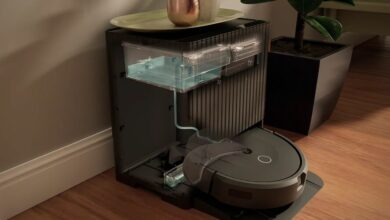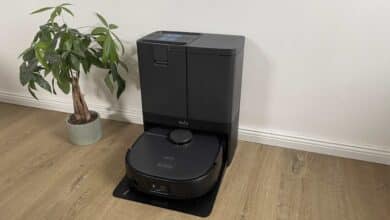
More and more households are getting help from a robot vacuum cleaner. This is more than understandable. After all, these smart household helpers are a helping hand that you won’t want to do without after just a few days of use. However, robotic vacuum cleaners no longer just come with a charging station. Suction or entire cleaning stations are designed to provide even more user convenience. This is also the case with the SwitchBot K10. However, the smart home expert was clearly pursuing a major goal when designing its compact robot vacuum. It is the smallest robot vacuum on the entire market. This should allow it to clean even the last corner of your home. In the SwitchBot K10 test, we check whether the mini form compromises performance or only offers major advantages.
SwitchBot enters a new market
SwitchBot’s product range is now truly impressive. It all began with the eponymous smart switch, which can be programmed as desired. The portfolio then continued to expand. The Chinese company has made a name for itself with gadgets such as a curtain robot in the form of the Curtain Rod(3rd generation test) or a smart door lock in the form of the SwitchBot Lock(test). But with a flourishing market such as the robot vacuum sector, it is clear that SwitchBot also wants a slice of the pie.

But how can you stand out from the other models in the face of huge competition? SwitchBot decided to focus on the form factor. The K10 has surprisingly compact dimensions, making it look like a dwarf among robot vacuums. This means that SwitchBot outperforms the competition in terms of size. After all, smart household helpers usually take up a lot of space, especially with a suitable suction station.

Technical data
| Robot vacuum cleaner dimensions and weight | 248 x 248 x 92 mm, approx. 2.3 kg |
| Dimensions and weight of suction station | 261 x 210 x 323 mm, approx. 3.6 kg |
| Material | ABS plastic |
| Suction power | 2.500 Pascal |
| Suction levels | 4 levels (Quiet/600pa, Standard/1,100pa, Strong/1,600pa, Max/2,500pa) |
| Navigation | LiDAR |
| Dust bag volume | 4 l |
| App operation | Yes, SwitchBot app |
| Voice assistants | Amazon Alexa, Google Home, Apple HomeKit |
| Price | € 487.60 * |
Scope of delivery
Boxes containing robot hoovers with suction or even cleaning stations are usually heavier than their size would suggest. This is not the case with the SwitchBot K10. Not only does it come in compact packaging. On top of that, the weight is surprisingly low. When you open it, it becomes clear why this is the case. Compared to conventional models in this market segment, the K10 is downright tiny.
The same applies to the suction station, the dimensions of which have been adapted to the robot hoover. In addition to the smart household helper and the suction station, the scope of delivery also includes a replacement side brush, a replacement filter, a replacement suction bag and a mopping plate along with 30 wet wipes for using the mopping function. The whole package is rounded off with the operating instructions.
SwitchBot K10 test: A stylish compact vacuum cleaner
When talking about the look and design of the K10, there’s no getting around the form factor. After all, this is clearly the unique selling point of this smart household helper. With a diameter of just under 25 cm, it is downright tiny. By comparison, a Roborock Q8 Max (test) has a diameter of just under 35 cm. There is no difference in height. This is because SwitchBot also relies on LiDAR technology.
This is concealed under the small turret in the middle of the top. Due to the laser sensor technology, it measures around 9 cm in height, which corresponds to the average of other models with LiDAR. It is not only the LiDAR unit on the top that corresponds to the standard equipment of modern robot hoovers. Apart from that, you don’t have to compromise on features either. There are two buttons on the top with which you can switch the vacuum cleaner on or send it home to its suction station.
The lid holds magnetically, which is reminiscent of the latest models in the Dreame family such as the L20 Ultra(test). How well you like this is certainly a matter of taste. I prefer the good old hinged lift-up mechanism. Under the cover you then have access to the dust container and the on/off button. There are additional sensors on the front to prevent collisions. In an emergency, there is a bumper to prevent damage to furniture. If you turn the robot vacuum on its back, you can see the cleaning brush on the underside.
Unfortunately, SwitchBot relies on a combination of rubber blades and old-fashioned brushes. Pet owners in particular who have to deal with a lot of pet hair should be aware of this. After all, they tend to get tangled up in the bristles. I would have preferred a solid rubber solution here. You can also see a side brush, which is designed to remove dirt from corners. The build quality of this smart household helper is really excellent. Even though SwitchBot relies on plastic here, the white housing makes a great impression. It doesn’t crack or creak at any point.
SwitchBot K10 test: Compact vacuum station
The plus sign in the name stands for the suction station, which is placed alongside the K10. Visually, it is the perfect complement to the small domestic robot. It measures just 26 x 33 x 20 cm, which also makes it significantly smaller than the competition. High-quality plastic is also used here, which makes a great impression in practice. The compact dimensions make up for a decisive disadvantage of many suction stations. The sometimes huge base stations from other manufacturers are particularly difficult to place in a small apartment.
The SwitchBot K10, on the other hand, fits into small corners without immediately catching the eye. If you don’t have a lot of space in your own four walls, you will clearly benefit from this. Of course, the compact dimensions of the vacuum station also raise the question of the corresponding volume. Can it collect as much dust and dirt as the competition? SwitchBot claims a total volume of 4 liters. That should be enough for 70 days, i.e. two months. Considering the small form factor, this is really impressive. Even larger models rarely offer more volume.
SwitchBot K10 test: Setup with the SwitchBot app
Setting up the small but mighty robot hoover is child’s play. Anything else would have surprised me in view of SwitchBot’s smart home expertise. Once you have installed the manufacturer’s app on your smartphone and created a user account, you can easily add the robot hoover as a new device. The software supports you with practical step-by-step instructions. After commissioning, the app scores with a great overview. This is reminiscent of the apps from market giants such as Roborock or Dreame. Even if this is your first robot hoover, you will quickly find your way around.
The app focuses on the map of your home that the K10 creates during its first exploration tour. In the two-dimensional map, you can then make changes to the automatic room division, for example. You can also select certain areas to be avoided or specifically cleaned by the vacuum cleaner. Once you have adjusted the cleaning settings to your requirements, you can quickly start the cleaning tour using the quick access in the app. If you don’t want to do the whole thing manually every time, you can of course also create cleaning schedules. Here you can specify the time and days when cleaning should take place.
If you don’t speak English and value voice output, you will be disappointed with the K10. After all, the smart household helper only communicates with its user in either English or Japanese. This is currently still the case, but this is set to change in the course of February. According to SwitchBot, a suitable software update with a German language package and a complete text translation into German will then be released. All in all, the app cuts a good figure in practice and scores points for ease of use. Those who like it particularly convenient can also start the vacuum cleaner with their voice. After all, the smart household helper is compatible with the common voice assistants Amazon Alexa, Google Home and Apple HomeKit.
SwitchBot K10 test: Navigation
For a robot vacuum cleaner to work effectively, navigation capability plays a very important role alongside sheer cleaning power. The small household helper finds its way around the home easily. It scores particularly well in tight areas such as corners or between chair legs. This is where the small housing size comes into its own. If there are no obstacles in the way, the K10 moves systematically across your floors.

In doing so, it primarily relies on straight paths that it follows parallel through your home. On top of this, it also sweeps around the edge of the room to catch any dirt on the baseboard. If it gets stuck, the little vacuum cleaner dwarf sometimes seems a little defiant. It is not uncommon for him to suddenly set off at full throttle to overcome barriers.
Thanks to the bumper at the front, you don’t have to worry about your furniture. However, the compact dimensions not only have advantages, but also a decisive disadvantage. Given its smaller size, the vacuum cleaner naturally takes longer to clean rooms. I don’t really find this annoying.
However, if you have a large home and want it to be cleaned in one go in as little time as possible, you should keep this in mind. If, on the other hand, you haven’t used a robot vacuum yet because you have many corners in your home that remain uncleaned, the K10 may be the right solution.
SwitchBot K10 test: Great suction power
With a suction power of 2,500 Pascal, the small SwitchBot just about plays in the middle class. For comparison: A Roborock S8 Pro Ultra(test) has an impressive 6,000 Pascal instead. However, the whole thing has to be calculated down to the more compact size of the K10. The fact that 2,500 Pascal ensures a sufficiently strong vacuum with the small housing becomes clear during the first cleaning tour.

It not only performs well on parquet, tiles and vinyl and skillfully collects dust, hair and other dirt. It can also make a good impression on carpets. The result on carpets may not be on a par with the flagships, but if you don’t have much carpeting in your home anyway, you won’t mind.
Owners of long-pile carpets should bear in mind that the K10 tends to get stuck here. However, these are a red rag for almost every robot vacuum cleaner. For me as a pet owner, the main brush is really annoying. It’s only a matter of time before the pet hair gets tangled up here for the first time. I also have to complain about the size of the dust container, which is located inside the robot vacuum.
If the K10 didn’t come with a suitable suction station, you would probably have to empty the container after every cleaning session due to its extremely small volume of just 150 ml. In combination with the station, however, this is not a problem. After cleaning, the vacuum cleaner returns to its suction station and the collected dirt is removed. The suction process may be very loud, but it is also completed after a few seconds.
SwitchBot K10 test: Mopping function unusable
The smart household helper also comes with a mopping plate and 30 wet wipes. This means it can also be used as a mopping robot. However, it is not possible to vacuum and mop at the same time. During the test, the wet wipes reminded me a little of the cleaning wipes from Swiffer. As they are only suitable for single use, I don’t think the whole thing makes much sense from both an ecological and an economic point of view. After all, unlike washable and reusable wipes, this principle generates a lot of waste. Buying new wipes is also expensive.

All of this might be manageable for some people if at least the cleaning performance was right. Unfortunately, you can forget about the K10’s wiping function. As the wet wipe simply loses moisture far too quickly, only a small area can be wiped with it. A wipe with permanent moistening simply has the edge here. What I find really practical, however, is that SwitchBot has even provided a separate space for the wiping plate despite the small dimensions of the suction station. You can place it under the lid.
SwitchBot K10 test: Battery
As already mentioned, the small size also results in a fairly long cleaning time. In the test, the smart household helper therefore needed just under 80 minutes to clean around 80 m² of floor space. Of course, there is no room for a gigantic battery in this small appliance, which is why the K10 is likely to run out of power when cleaning large areas. In my case, it had a remaining battery of 25 percent. This may not be on a par with the majority of full-size robot hoovers on the market, but in my opinion it is still a good value after almost an hour and a half of cleaning. Incidentally, SwitchBot states that the mini vacuum cleaner is primarily aimed at homes of around 80 m².
Conclusion
SwitchBot proves one thing above all with its K10: courage. The smart home expert tackles a problem that many other robot hoovers have – they are too big. This applies not only to the robot hoover itself, but also to its compact suction station. And the cleaning performance is also just right. The format definitely pays off, especially in corners and hard-to-reach places. However, the small form factor also has a decisive disadvantage. If you want a robot vacuum to finish the job quickly, you should steer clear of the K10.
After all, it takes considerably longer than its larger counterparts. In my opinion, SwitchBot could really have done without the mopping function. The concept with the damp cleaning cloths is not only ecologically questionable, but also results in annoying follow-up costs. In terms of ease of use, however, SwitchBot once again underlines its expertise in the smart home sector. Thanks to the clear app, operation is easy and virtually self-explanatory.
Switchbot K10
Workmanship & design
Hardware
Cleaning performance
Usability
Value for money
91/100
Behind the small housing of the Switchbot K10 is a huge piece of smart home technology.





